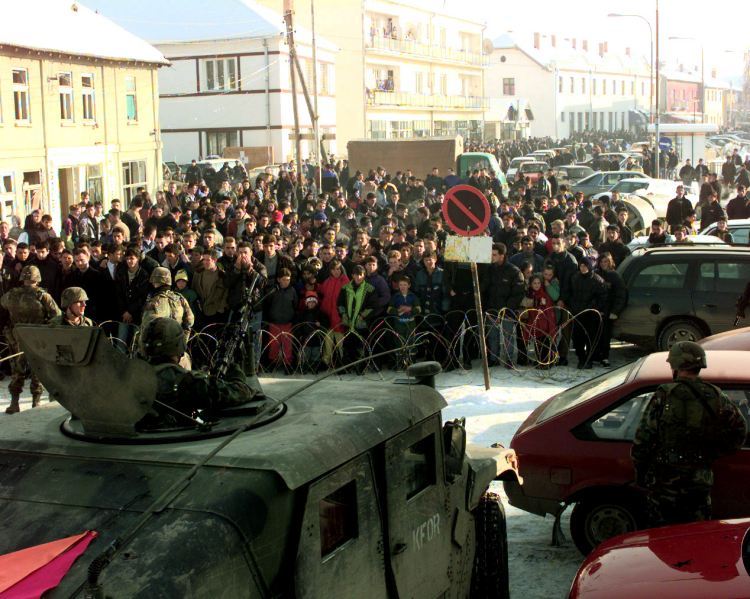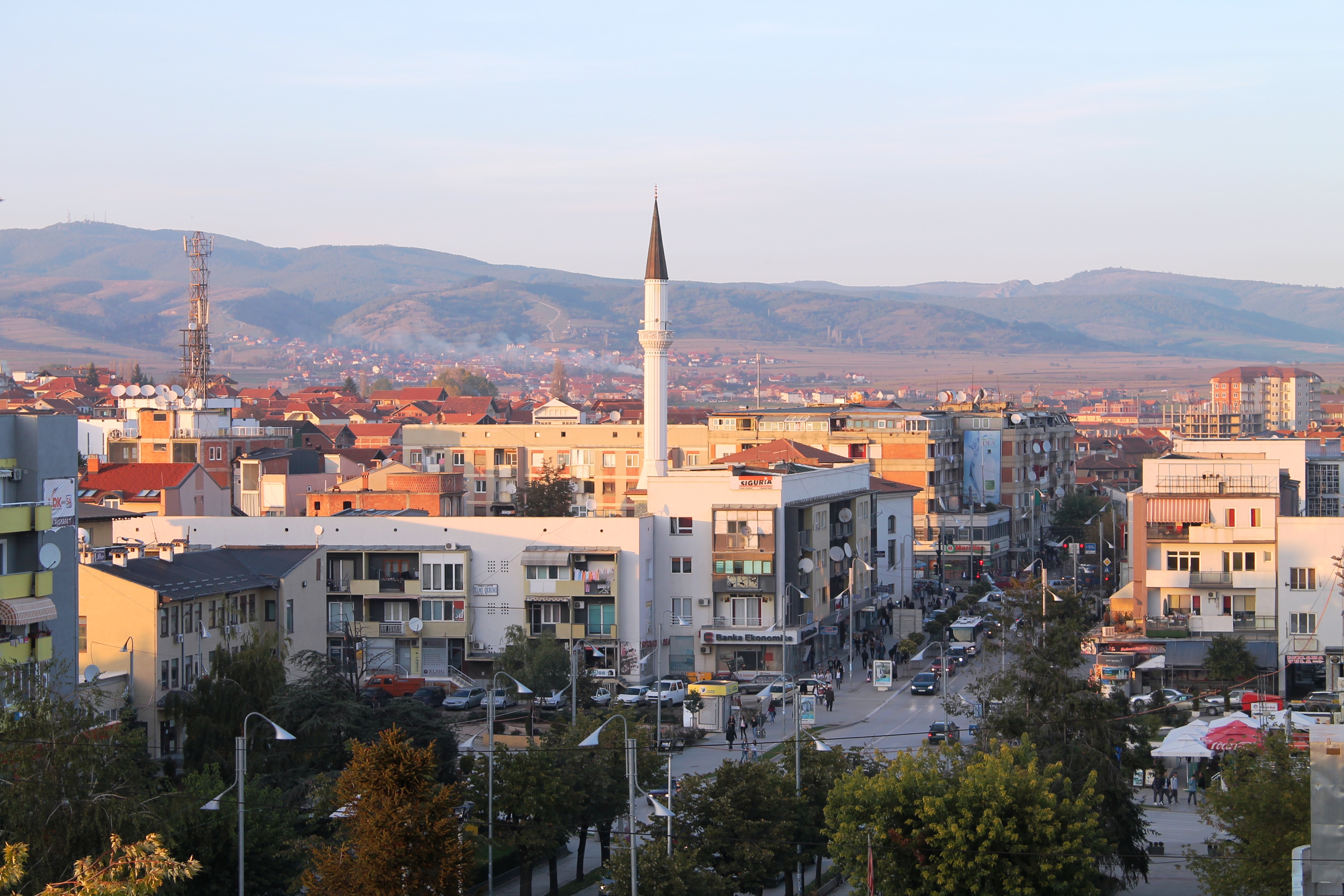|
Vitina
Viti ( sq-definite, Vitia) or Vitina ( sr-Cyrl, ÐÐļŅÐļÐ―Ð°), is a town and municipality located in the District of Gjilan in Kosovo. According to the 2011 census, the town of Viti has 4,924 inhabitants, while the municipality has 46,987 inhabitants. Municipality * BallancÃŦ/Balance * BeguncÃŦ/Begunce * Binça/BinaÄ * BudrikÃŦ e EpÃŦrme/Gornja Budrika * Buzovik * Ãifllak/Äiflak * DÃŦbÃŦlldeh/ Debelde * DevajÃŦ/Devaja * Drobesh/DrobeÅĄ * GÃŦrmovÃŦ/Grmovo * Gjylekar/ Äelekare * Goden i Madh/Veliki Goden * GushicÃŦ/GuÅĄica * Kabash/KabaÅĄ * LetnicÃŦ/Letnica * LubishtÃŦ/ LjubiÅĄte * Mjak/Mijak * NovosellÃŦ/Novo Selo * Podgorc/Podgorce * Pozharan/PoÅūaranje * Radivojc/Radivojce * Ramjan/Donje Ramnjane * RamnishtÃŦ/RavniÅĄte * Remnik/Ribnik * SadovinÃŦ e ÃerkezÃŦve/Äerkez Sadovina * SadovinÃŦ e Jerlive/Jerli Sadovina * ShasharÃŦ/Å aÅĄare * SllatinÃŦ e EpÃŦrme/Gornja Slatina * SllatinÃŦ e Poshtme/Donja Slatina * SmirÃŦ/ Smira * StubÃŦll e EpÃŦrme/Gornja Stubla * StubÃŦll e ... [...More Info...] [...Related Items...] OR: [Wikipedia] [Google] [Baidu] |
Laramans
The term Laraman in Albanian refers to crypto-Christians who adhered to Islam officially but continued to practice Christianity within the household during the Ottoman era. It was derived from the Albanian adjective ''i larmÃŦ'', meaning "variegated, motley, two-faced", a metaphor of "two-faithed" (''l'arÃŦ''), a reference to the Laramans following both Christianity (in secret) and Islam (nominally). The phenomenon was widespread in the mid to late Ottoman era among both northern and southern Albanians, and arose after half-hearted conversions in the contexts of anti-Christian persecution, to avoid payment of poll taxes, and to obtain worldly advantages such as government employment. While the Orthodox church typically tolerated crypto-Christians among its flocks, Catholic policy varied by place and time between having priests travel to ''laraman'' houses in secret, and categorically refusing anyone who called themselves Muslim in public sacraments. Legally, ''laraman'' individua ... [...More Info...] [...Related Items...] OR: [Wikipedia] [Google] [Baidu] |
BinaÄ
BinaÄ ( sr-cyr, ÐÐļÐ―aŅ) or Binça ( sq, BinçÃŦ), is a village in the municipality of Vitina in southeastern Kosovo. The BinaÄ Monastery was destroyed in 1999, during the Kosovo unrests. It is in the Kosovo Pomoravlje region. The BinaÄka Morava crosses beside the village. See also *Populated places in Kosovo The following is a list of populated places in Kosovo, arranged by Municipalities of Kosovo, municipality.http://www.unmikonline.org/regulations/unmikgazette/02english/E2004ads/ADE2004_23_annex.pdf Deçan (DeÄani) GjakovÃŦ (Ãakovica) Dren ... References Villages in Viti, Kosovo Medieval Serbian sites in Kosovo {{Kosovo-geo-stub ... [...More Info...] [...Related Items...] OR: [Wikipedia] [Google] [Baidu] |
Janjevci
Janjevci (, sq, JanjevÃŦt, sh-Latn-Cyrl, separator=" / ", Janjevci, ÐаŅÐĩÐēŅÐļ) or Kosovo Croats ( sq, KroatÃŦt e KosovÃŦs, sh-Latn-Cyrl, separator=" / ", Kosovski Hrvati, ÐÐūŅÐūÐēŅКÐļ ÐĨŅÐēаŅÐļ) are the Croats, Croat community in Kosovo, inhabiting the town of Janjevo and surrounding villages near Pristina, as well as villages centered on Vitina (town), Letnica near Vitina (town), Vitina (Å aÅĄare, Vrnez, and Vrnavokolo), who are also known as ''LetniÄani''. Identity and culture The Janjevci declare as ethnic Croats, and derive their ethnonym (''Janjevci'') from their traditional community centre, in Janjevo. It is believed that the community descends from migrating merchants from the Republic of Ragusa (Dubrovnik and its hinterland) who settled the area in the 14th century medieval Serbia. The first written mention of Catholics in Janjevo is a letter written by Pope Benedict XI in 1303, mentioning Janjevo as the center of the Catholic parish of St. Nicholas. Toget ... [...More Info...] [...Related Items...] OR: [Wikipedia] [Google] [Baidu] |
Populated Places In Kosovo
The following is a list of populated places in Kosovo, arranged by Municipalities of Kosovo, municipality.http://www.unmikonline.org/regulations/unmikgazette/02english/E2004ads/ADE2004_23_annex.pdf Deçan (DeÄani) GjakovÃŦ (Ãakovica) Drenas (Glogovac) Gjilan (Gnjilane) Dragash (DragaÅĄ) Istog (Istok) Kaçanik (KaÄanik) KlinÃŦ (Klina) FushÃŦ KosovÃŦ (Kosovo Polje) KamenicÃŦ (Kosovska Kamenica) MitrovicÃŦ (Kosovska Mitrovica) Leposaviq (LeposaviÄ) Lipjan (Lipljan) MalishevÃŦ (MaliÅĄevo) NovobÃŦrdÃŦ (Novo Brdo) Obiliq (ObiliÄ) Rahovec (Orahovac) PejÃŦ (PeÄ) PodujevÃŦ (Podujevo) PrishtinÃŦ (PriÅĄtina) Prizren SkÃŦnderaj (Srbica) Shtime (Å timlje) ShtÃŦrpcÃŦ (Å trpce) SuharekÃŦ (Suva Reka) Ferizaj (UroÅĄevac) Viti (Vitina) Vushtrri (VuÄitrn) Zubin Potok Zveçan (ZveÄan) See also * Administrative divisions of Kosovo * Districts of Kosovo * Municipalities of Kosovo * List of cities in Kosovo, Cities and towns in Kosov ... [...More Info...] [...Related Items...] OR: [Wikipedia] [Google] [Baidu] |
District Of Gjilan
The District of Gjilan ( sq, Rajoni i Gjilanit) is one of the seven districts (the higher-level administrative divisions) of Kosovo. Its seat is in the city of Gjilan. History Anamorava, literally "side of river of Morava", is the hilly countryside in south eastern Kosovo south of Gjilan and on the BinaÄka Morava. It stretches eastward to the PreÅĄevo (Presheva) valley in southern Serbia. The mountains in this region rise to an altitude of 1,000 to 1,200 meters, and culminate in the Karadak region bordering neighboring North Macedonia north of Skopje. Municipalities The district of Gjilan has a total of 6 municipalities and 287 other smaller settlements: Ethnic groups In 1991, all municipalities of the district had an Albanian majority: Gjilan (Gnjilane) (76.54%), Kamenica (Dardana) (73.05%), Vitina (Vitia) (78.68%). In the 2011 census, after the creation of new municipalities with Serb population, Albanians are the majority in: Gjilan (Gnjilane) (97.4%), Kamenica ( ... [...More Info...] [...Related Items...] OR: [Wikipedia] [Google] [Baidu] |
KabaÅĄ
Kabash (, ) is a town in the Vitina Municipality of southeast Kosovo.GNS names History The ancestors of the inhabitants of the village belong to the Kabashi tribe. The Austro-Hungarian Austria-Hungary, often referred to as the Austro-Hungarian Empire,, the Dual Monarchy, or Austria, was a constitutional monarchy and great power in Central Europe between 1867 and 1918. It was formed with the Austro-Hungarian Compromise of ... consulate in Belgrade reported that during February 1913, Serbian military forces executed all Albanian inhabitants of the villages of Kabash, TÃŦrpezÃŦ, Lubisht and Gjylekar. Geography The village is located in the Anamorava valley and is stiuated on the foot of the Karadak mountains. Notes and references Notes: References: Villages in Viti, Kosovo {{Kosovo-geo-stub ... [...More Info...] [...Related Items...] OR: [Wikipedia] [Google] [Baidu] |
PoÅūaranje
Pozharan (in Albanian), or PoÅūaranje (in Serbian; ÐÐūÐķаŅаŅÐĩ) is a town in the Vitina Municipality, southeast Kosovo. History Until 1975, it was known as PoÅūeranje (ÐÐūÐķÐĩŅаŅÐĩ) and had been the seat of its municipality to that time. Demographics According to the 2011 census the population is 10,000, of which 99,53% are ethnic Albanians. Sports The local football club is KF Vllaznia Pozheran, who played in the Football Superleague of Kosovo in the 2017â18 season. Notable people * Sinan Hasani, Yugoslav politician * Mejdi Korrani (d. 19/4/1999), KLA * Xhevat Qerimi, KLA commander * Naser e Jeton Rama, KLA * Festim Alidema Football *Sami Piraj, composer *Lindita Halimi Lindita Halimi (born 24 March 1989), commonly known as simply Lindita, is a Kosovo-Albanian singer and songwriter. She rose to fame after winning the sixth edition of Top Fest with "ÃndÃŦrroja" (I dreamed) in 2009. In 2016, she participated in ..., singer References Villages in Viti ... [...More Info...] [...Related Items...] OR: [Wikipedia] [Google] [Baidu] |
Municipalities Of Kosovo
A municipality ( sq, komuna, sr, / ) is the basic administrative division in Kosovo and constitutes the only level of power in local governance. There are 38 municipalities in Kosovo; 27 of which have an Albanian ethnic majority, 10 Serb and 1 Turkish. After the 2013 Brussels Agreement, signed by the governments of Kosovo and Serbia, an agreement was made to create a Community of Serb Municipalities, which would operate within Kosovo's legal framework. Since 2013, the agreement has not been fulfilled by Kosovo's authorities, calling upon its constitution and "territorial integrity". Serbia does not recognize Kosovo as a sovereign state, but as an autonomous province according to its constitution. List of Municipalities Powers of municipalities All municipalities have the following competences, as regulated by Law Nr. 03/L-040 of the Constitution of Kosovo: # Local economic development. # Urban and rural planning. # Land use and development. # Implementation of building ... [...More Info...] [...Related Items...] OR: [Wikipedia] [Google] [Baidu] |
PreÅĄevo
PreÅĄevo ( sr-cyrl, ÐŅÐĩŅÐĩÐēÐū; sq, PreshevÃŦ, ) is a town and municipality located in the PÄinja District of southern Serbia. It is the southernmost town in Central Serbia and largest in the geographical region of PreÅĄevo Valley. PreÅĄevo is the cultural center of Albanians in Serbia. According to the 2022 census, the town of PreÅĄevo had a population of 16,426 people, while the municipality had 59,104 inhabitants. Albanians form the ethnic majority of the municipality, followed by Serbs, Roma and other ethnic groups. History Slavs arrived roughly in the 7th century, when they first migrated to the Balkans, and by the Middle Ages, PreÅĄevo was part of the Kingdom of Serbia. According to Stefan DuÅĄan's charter to the monastery of Arhiljevica dated August 1355, ''sevastokrator'' Dejan possessed a large province east of Skopska Crna Gora. It included the old '' Åūupe'' (counties) of Å―egligovo and PreÅĄevo (modern Kumanovo region with Sredorek, KozjaÄija and the larger ... [...More Info...] [...Related Items...] OR: [Wikipedia] [Google] [Baidu] |
Church Of The Holy Mother Of God, Podgorce
Church of the Holy Mother of God was a Serbian Orthodox Church located in the village of Podgorce, in the municipality of Vitina, in Kosovo and Metohija. It belonged to the Diocese of RaÅĄka and Prizren of the Serbian Orthodox Church. The church was rebuilt and consecrated in 1996. The destruction of the church in 1999 The church was looted and burned by Kosovo Albanians after the arrival of the US KFOR KFOR may refer to: * KFOR (AM), a radio station (1240 AM) licensed to Lincoln, Nebraska, United States * KFOR-TV, a television station (channel 4 analog/27 digital) licensed to Oklahoma City, Oklahoma, United States * KFOR-TV (Nebraska), a defunct ... troops. References External links The list of destroyed and desecrated churches in Kosovo and Metohija June-October 1999 (ÐĄÐŋÐļŅаК ŅÐ―ÐļŅŅÐĩÐ―ÐļŅ Ðļ ÐūŅКŅÐ―Ð°ÐēŅÐĩÐ―ÐļŅ ŅŅКаÐēа Ð―Ð° ÐÐūŅÐūÐēŅ Ðļ ÐÐĩŅÐūŅ ÐļŅÐļ ŅŅÐ―-ÐūКŅÐūÐąÐ°Ņ 1999) {{DEFAULTSORT:Church of the Holy Mother of God, Podgorce Ser ... [...More Info...] [...Related Items...] OR: [Wikipedia] [Google] [Baidu] |
DÃŦbÃŦlldeh
DÃŦbÃŦlldeh (, ) is a village in the municipality of Vitia, Kosovo. Etymology The name of the village comes from the Serbian words "Debeli Deo" () which translated into English mean "Thick Place" Geography The village is located in the Karadak Mountain range, northwest of Kopilaq Mountain. It borders the village of Mjak in the west and TanuÅĄevci in the south which is located in North Macedonia. History The inhabitants of the village belong to the same clan originating from the Berisha tribe and are separated into two branches; The Mahalla of Fejzalar with nine families, and the Mahalla of Qorroll with thirteen families. During the Kosovo War, most of the village was burned down and property was looted by Serb Forces During the Conflict in Macedonia in 2001, the village became a stronghold of the NLA, from which many attacks on Macedonian forces were conducted. Following an agreement between Serbia and Montenegro Serbia and Montenegro ( sr, CŅÐąÐļŅа Ðļ ÐĶŅ ... [...More Info...] [...Related Items...] OR: [Wikipedia] [Google] [Baidu] |
LubishtÃŦ
LubishtÃŦ (, ) is a village in the municipality of Vitia, Kosovo Kosovo ( sq, Kosova or ; sr-Cyrl, ÐÐūŅÐūÐēÐū ), officially the Republic of Kosovo ( sq, Republika e KosovÃŦs, links=no; sr, Ð ÐĩÐŋŅÐąÐŧÐļКа ÐÐūŅÐūÐēÐū, Republika Kosovo, links=no), is a partially recognised state in Southeast Euro .... Geography The village is located in the Karadak Mountain range and borders the Anamorava valley to the North. History The ancestors of the inhabitants of the village belong to the Sopi tribe. Notes and references Notes: References: Villages in Viti, Kosovo {{Kosovo-geo-stub ... [...More Info...] [...Related Items...] OR: [Wikipedia] [Google] [Baidu] |



